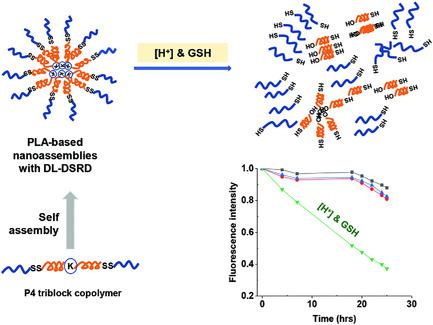当前位置:
X-MOL 学术
›
Macromol. Rapid Commun.
›
论文详情
Our official English website, www.x-mol.net, welcomes your feedback! (Note: you will need to create a separate account there.)
PLA‐Based Triblock Copolymer Micelles Exhibiting Dual Acidic pH/Reduction Responses at Dual Core and Core/Corona Interface Locations
Macromolecular Rapid Communications ( IF 4.6 ) Pub Date : 2018-10-04 , DOI: 10.1002/marc.201800477 Kamaljeet Kaur Bawa 1 , Arman Moini Jazani 1 , Chaitra Shetty 1 , Jung Kwon Oh 1
Macromolecular Rapid Communications ( IF 4.6 ) Pub Date : 2018-10-04 , DOI: 10.1002/marc.201800477 Kamaljeet Kaur Bawa 1 , Arman Moini Jazani 1 , Chaitra Shetty 1 , Jung Kwon Oh 1
Affiliation

|
Polylactide (PLA)‐based amphiphilic block copolymers and their nanoassemblies designed with stimuli‐responsive degradation (SRD) hold great potential as promising candidates for tumor‐targeting drug delivery. However, most of the smart PLA‐based nanoassemblies are designed to respond to a single stimulus (typically reduction or acidic pH). Herein, a new strategy is reported to synthesize PLA‐based block copolymer micelles exhibiting dual SRD at dual locations (DL‐DSRD). The strategy utilizes a combination of ring opening polymerization, controlled radical polymerization, and facile coupling reactions to synthesize an ABA‐type PLA‐based triblock copolymer with a hydrophilic polymethacrylate (A) and PLA (B) blocks. Incorporation of an acidic pH‐responsive ketal linkage in the center of PLA block and reduction‐responsive disulfide linkages at PLA/hydrophilic polymethacrylate blocks ensure the formation of smart nanoassemblies featured with ketal linkages in the PLA cores and disulfide linkages at core/corona interfaces, thus attaining DL‐DSRD. Such dual acidic pH/reduction‐responses at dual locations lead to not only shedding of coronas at interfaces but also destabilization of cores, resulting in the synergistic and accelerated release of encapsulated model drugs, compared with the single stimulus systems. These results, along with lower cytotoxicity, suggest that DL‐DSRD strategy can offer versatility in the development of tumor‐targeting drug delivery nanocarriers.
中文翻译:

基于PLA的Triblock共聚物胶束在双核和核/电晕界面位置均表现出双酸性pH /还原反应
基于聚丙交酯(PLA)的两亲嵌段共聚物及其纳米组件具有刺激响应降解(SRD)的设计,有望成为靶向肿瘤药物的潜在候选药物。但是,大多数基于PLA的智能纳米组件都旨在响应单个刺激(通常是还原或酸性pH)。本文报道了一种新的策略来合成基于PLA的嵌段共聚物胶束,该胶束在两个位置都具有双SRD(DL-DSRD)。该策略结合了开环聚合,受控自由基聚合和易偶联反应的组合,以合成具有亲水性聚甲基丙烯酸酯(A)和PLA(B)嵌段的ABA型PLA基三嵌段共聚物。在PLA嵌段的中心引入酸性的pH响应性缩酮键,并在PLA /亲水性聚甲基丙烯酸酯嵌段中引入还原响应性二硫键,从而确保形成智能的纳米组件,其特征在于PLA核中具有缩酮键,而在核/电晕界面处具有二硫键,从而达到DL‐DSRD。与单一刺激系统相比,这种双重酸性pH /还原反应在双重位置不仅导致界面处电晕的脱落,而且导致核心不稳定,从而导致封装的模型药物协同和加速释放。这些结果以及较低的细胞毒性表明,DL‐DSRD策略可在靶向肿瘤的药物输送纳米载体的开发中提供多功能性。
更新日期:2018-10-04
中文翻译:

基于PLA的Triblock共聚物胶束在双核和核/电晕界面位置均表现出双酸性pH /还原反应
基于聚丙交酯(PLA)的两亲嵌段共聚物及其纳米组件具有刺激响应降解(SRD)的设计,有望成为靶向肿瘤药物的潜在候选药物。但是,大多数基于PLA的智能纳米组件都旨在响应单个刺激(通常是还原或酸性pH)。本文报道了一种新的策略来合成基于PLA的嵌段共聚物胶束,该胶束在两个位置都具有双SRD(DL-DSRD)。该策略结合了开环聚合,受控自由基聚合和易偶联反应的组合,以合成具有亲水性聚甲基丙烯酸酯(A)和PLA(B)嵌段的ABA型PLA基三嵌段共聚物。在PLA嵌段的中心引入酸性的pH响应性缩酮键,并在PLA /亲水性聚甲基丙烯酸酯嵌段中引入还原响应性二硫键,从而确保形成智能的纳米组件,其特征在于PLA核中具有缩酮键,而在核/电晕界面处具有二硫键,从而达到DL‐DSRD。与单一刺激系统相比,这种双重酸性pH /还原反应在双重位置不仅导致界面处电晕的脱落,而且导致核心不稳定,从而导致封装的模型药物协同和加速释放。这些结果以及较低的细胞毒性表明,DL‐DSRD策略可在靶向肿瘤的药物输送纳米载体的开发中提供多功能性。



























 京公网安备 11010802027423号
京公网安备 11010802027423号